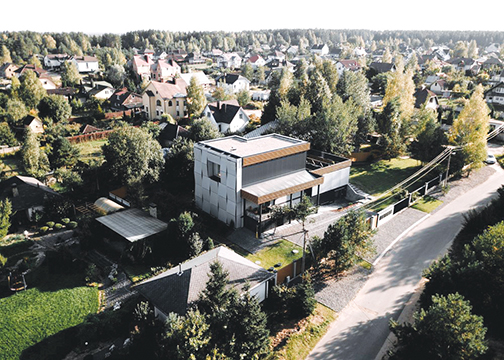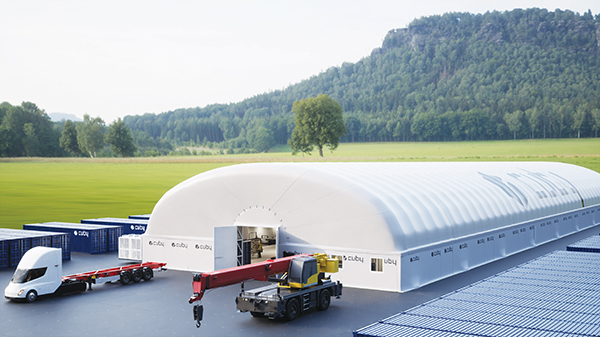This startup plans to build prefabricated homes in temporary pop-up factories.
- Rather than modules or panels, they will manufacture homes as a kit of parts that can be assembled on-site by unskilled workers.
- For efficiency, every factory will be exactly the same, and can be moved to a new site when needed.
- The company claims that, unlike modular, they can deliver a finished house for less cost than stick framing. They insist that this savings is what will really appeal to developers.
Cuby Technologies is headquartered in Wilmington, Delaware, but the company embraces remote work, and their team of 137 is globally distributed. Their engineering R&D base is in Eastern Europe. The company was informally founded in 2018, but officially launched in 2021.
They have devised a system for manufacturing steel-framed prefab homes as kits of parts in temporary pop-up factories, using unskilled workers. The factories can be placed close to where the homes will be built.
We talked with Cuby’s CEO and Co-Founder, Aleksandr Gampel, about the company’s unusual business model, and what people thinking of moving into the prefab industry might learn from Cuby’s approach and the research that went into it.

Business Model & Markets
Cuby’s current goal is to partner with developers, general contractors, or investors to set up hundreds of “mobile micro-factories” in areas of high demand around the globe.
A crucial part of the model is “extending the factory environment to the jobsite,” Gampel says. The factories are 30,000 sq. ft. and employ unskilled workers to manufacture kits of parts that are delivered on pallets. They also deliver a couple of containers to the jobsite that contain all the tools needed to assemble the home from the kits of parts. (The containers also have bathrooms, showers and lockers.)
With the tools in the containers and the kits of parts, Gampel says, “Four unskilled workers in two shifts can put together an entire home in 30 to 45 days.”
For now, Cuby is focusing on single-family homes, and he points out that there is a shortage of millions of homes in the US. “Pick a dot anywhere on the map, you can for sure support 200 single-family homes a year. In most cases the markets we’ll enter can do 10,000 homes a year,” Gampel says. “If we can be cheaper for the local developers, then we can win in those markets.”
The company also plans to expand into other types of buildings in the future.

The Factories
According to Gampel, the company has spent 310,000 engineering hours to reach commercialization. (For reference, he mentions it takes around 700,000 engineering hours to build a fighter jet.) That engineering expertise went into designing a factory that’s replicable, mobile and relatively inexpensive to erect.
The factories are containerized around the perimeter and once the containers are in place, the structure is inflated to form the roof. The containers are delivered with all the machines needed for the factory’s operation already inside. “The machines are either designed and custom-manufactured by us, or they’re machines we bought off the shelf and re-tooled to make them custom to Cuby,” says Gampel.
Although the factories are mobile, they’re not intended to be moved frequently. A factory can serve the same market for as long as it needs to, which “could be 10 years within a 300-mile radius.”
What’s important is that they’re easy to move to their location, quick to set up and they’re non-permanent structures. “We didn’t want to have to search for land and then build for four to seven years each time we wanted to set up a factory,” Gampel says. “Our factories are non-permanent structures that can be erected quickly — in about eight weeks. We can rent parking lots and operate in light manufacturing zones.”
It was also important for the company to be able to tap into local supply chains. “The things that feed our factory, our bill of materials, are all things that could, in theory, be bought at Home Depot,” Gampel says.
Crucially, Cuby’s system requires the same factory floorplan every time — which would be impossible if relying on renting factory space. “Our software reads the floorplan and spits out the tasks for the workers. We needed our factories to be the same product every time in every market,” Gampel explains.
Factory Partners
To launch these factories in a specific market, Cuby partners with local builders and developers who are successful in that geographical area. The partner could be a big company like Lennar, that builds thousands of homes a year. “Or the partner might not build homes themselves but might sell to smaller builders who are doing 20 or 30 homes a year.”
Gampel says the micro-factories cost less than $10 million to set up, compared to $50 million to $250 million for what he calls ‘giga-factories’ — the large plants typically needed for prefab manufacturing.
Later, once the concept is well-proven, Cuby plans to get financial backing to launch and own the factories themselves, without the need for partners.
In Eastern Europe, Cuby has designed, manufactured and launched their first test mobile micro-factory. “We’re slowly turning it on now, and it’s starting to manufacture our kits of parts, which we’re assembling into case studies [i.e. single-family homes].”
In addition to their case study homes in Eastern Europe, they’re also building some in the United States (in Southampton, Pa. and Detroit, Mich.).
Cuby’s first micro-factory on the partnership model will be launched in Detroit, partnering with a “sizable regional contractor that employs about 200 people at any given time.” Gampel says this company “sees the writing on the wall. Their workforce is aging, and they can’t replace them quickly enough and so have to turn down business.” Cuby also has LOIs [Letters of Intent] with other partners in other regions.
Labor Needs
“The whole point of the system is to reduce the need for skilled labor,” Gampel says. “Currently, it takes too many labor hours to build a house, existing labor is unproductive and there’s a skilled labor shortage — which is getting worse as the workforce ages and young people don’t want to be construction workers. We’ve been under-building and so there’s a massive shortage of housing,” Gampel says. “On the other hand, there’s massive demand. Therefore, housing is expensive.” Cuby hopes to address both the labor issue and the high cost of housing.
The micro-factories, at their maximum output, will employ about 260 unskilled workers. “That’s about 70 people in two shifts in the factory itself. The rest will be distributed among the various construction sites.” At full capacity, each factory can serve 20 construction sites within its radius.
Cuby’s manufacturing and assembly process is broken down into small, easy-to-perform steps, so they can be done by unskilled workers. The company’s software assigns tasks to the workers and shows people how to do them “via digital twins in Unreal Engine.” Unreal Engine is 3D graphics software, which can be used for many different applications, including video games.

The Kit of Parts
Cuby’s software can translate any house design into a kit of parts. They need not stick to repeated designs, and custom homes aren’t a problem.
The kit of parts doesn’t include closed structural wall panels that contain MEP because Cuby wants to avoid having to deal with inspectors who are unfamiliar with prefab. They also wanted to ensure that the parts in the kit were familiar and recognizable to any GC — it’s just that the sheetrock, plumbing pipes, wiring etc. are already pre-cut or prepped.
And, because the homes are steel framed, the kits don’t contain any framing lumber.
The kits are designed so they don’t require skilled labor to assemble them. Gampel gave a couple of examples of how they make assembly easier. The exterior part of their walls are non-structural panels with insulation on the inside and galvanized steel on the outside. These are “basic panels that have existed in the market for a long time,” Gampel says. In the factory, they take any façade or finish and add a magnetic film to it. “Then the façade can be attached on-site [to the galvanized steel on the wall panels] very quickly and requiring very little skill.”
They also manufacture their own windows, which are designed to be easy to install. “We have a click-in-place system for our windows so they can be quickly screwed in and sealed.”

Cost Savings
Gampel says that most modular or panelized systems aren’t cheaper to build with than conventional construction. Manufacturers offer time savings and quality assurance, but as a former developer, he’s skeptical that this is enough benefit for the marketplace. “That’s not how a developer underwrites a real estate investment. Some developers will bite, but most do not speculate like that in their Excel models.”
By contrast, Cuby offers a very simple selling proposition. The average stick-built single-family home is about $185 per sq. ft.,” Gampel says. “But we can produce single-family homes for about $100 per sq. ft. — including labor costs — and with time, this will get lower.” However, he notes that the top 10 US homebuilders have pretty good efficiencies and that their prices will be lower than the average. Costs will also vary by geographical markets.

Why Not Volumetric Modular?
Gampel mentions several reasons Cuby rejected volumetric modular, based on their research. The first is that it’s expensive for manufacturers. “You need these giga-factories and, because of the factory costs, it needs to output millions of sq. ft.,” he says. “Which is tough [to do consistently], because real estate is cyclical.”
The logistics around volumetric modular also generate high costs. “You’re shipping a lot of air, which is expensive,” Gampel says. As a result, modular construction isn’t cheaper than ordinary stick-built construction.
Volumetric modules are supplied to GCs — who have to radically change how they’re used to working in order to use them. Gampel thinks that’s a lot to ask.
Another way volumetric modular requires a change in the construction industry, rather than adapting to it, is in financing. Manufacturers need to be paid upfront, “which doesn’t tie well to how developers usually draw on their debt schedules or how lenders work — so there are challenges in funding this product.”
When modular works best, there’s very little customization, as is the case with hotels, Gampel says. “Citizen M has done this very well,” he adds. But for the single-family home market, he thinks it’s important to be able to offer more variability.
Having a factory at a great distance from the jobsite can also be an issue. But Cuby “wants to shrink the gap between factory and site, with the same unskilled labor being deployed on-site with the tools and hardware they need to put a house together.”
The issue of skilled labor is another problem he sees with much of the prefab industry. “When you go inside some offsite production facilities, there’s still skilled labor swinging hammers. It’s not really manufacturing,” he says. So, if someone’s thinking of entering the industry, it would be wise to make sure their factory’s processes require little skill. He says that Cuby is “hiring the same folks that Amazon is hiring for their warehouses.”
Ultimately, Gampel thinks it’s hard to make big changes in the construction industry. “Real estate is a very slow-to-change space. GCs, lenders, developers are all very conservative,” he says. “And they have no reason to change unless you give them real value to take a risk on adopting something that’s new to them.”
Zena Ryder writes about construction and robotics for businesses, magazines, and websites. Find her at zenafreelancewriter.com.

















